John Hurrell – 9 May, 2018
Enberg's talent lies in his ability to create mysteriously resonating symbolic objects, and to prod the viewer into devising connections between these seemingly unrelated bundles by exploiting free association and suggestion. And although his activity can be seen as a variation of Duchampian dandyism, presenting an esoteric Euro-focussed practice completely at odds with the current zeitgeist and the prevailing global drive for radical political change, there is a vivid sense that Enberg is very aware of these overarching contextual tensions, and builds them in.
If you’ve ever eaten Turducken, that poultry dish where three birds are sequentially (telescopically) inserted into each other and roasted, you might be amused (or horrified) by the transcript of Oscar Enberg‘s radio play/libretto—provided in the blurb for his latest show at Hopkinson Mossman. In it he references a recipe by Grimod de la Reyniere (1758-1837), the Napoleonic era chef considered one of the founders of modern French cuisine. This dish features sixteen species of increasingly-sized bird, ranging from a warbler to a turkey.
Enberg’s typically complex exhibition (with its characteristic love of language) has many interlinked components—the radio play is just as important as the wall displays. And some of its text ends up on the walls—excerpts with garnishes—between carving knives made of folded steel (like Samurai swords), providing gruesome allusions to not just poultry or bread being cut up. De la Reyniere was alive during Robespierre’s Reign of Terror (1793-1794) and his mother barely escaped execution, so Enberg’s references to (the ‘well mortified’) Miss Volnais, Mrs Belmont, Miss D. Vienne, Miss L. Contat and Miss Arsène (see illustrations) are extremely loaded.
Of course they are unabashedly sexual too—a stained glass window with the Edmonds’ ‘Sure to Rise’ sun motif inverted but at the top, seems to allude to impotency with the title, It is sure to rise, Madam, while the titles of the carving knives reference cuckolding, and the figure in the basket near the entrance (offering you bread) has two ‘cuckold’ horns.
While the show is called Power & Taste, the title reiterated in the letters on the hanging mugs, there is more involved than just having an appetite for bird flesh—and the ability to summon it. Speculation is encouraged.
Enberg’s talent lies in his ability to create mysteriously resonating symbolic objects—semiotic clusters—and to prod the viewer into devising connections between these normally unrelated bundles by exploiting free association and suggestion. And although his activity can be seen as a variation of Duchampian dandyism, presenting an esoteric Euro-focussed practice completely at odds with the current zeitgeist and the prevailing global drive for radical political change, there is a vivid sense that Enberg is very aware of these overarching contextual tensions, and builds them in. There is self-reflexivity too.
The title is also a prologue, and so there is a sense of dramatic art historical events about to become manifest—a racially based struggle for power in the artworld perhaps—where Eurocentric white ‘gatekeepers’ end up being discarded.
There are lots of other levels too. In one work, ‘Family of Man’. The Fall of Man, we see a string of kitsch greeting cards hung across a fireplace supporting German carved heads that are giant bottlestops. One of the cards below these bodiless heads shows a child gleefully strangling a cat. Such violence could be ironic, but not necessarily. It’s more likely to be black humour, and perhaps a reference to Original Sin.
The two galleries could also be split in a Blakean sense, between ‘Songs of Innocence’ (Gallery One), and ‘Songs of Experience’ (Gallery Two)—separated by a rectangular stained glass ‘Sun’ image that might refer to the guillotine and a severed neck. Or split between ‘Taste‘ (some bread to nibble on) and ‘Power’ (women treated as poultry).
We are presented with a sort of visual fable that is dense with symbols, tangential allusions, and conceptual loops. Like those famous Matryoshkan Russian dolls where each contains a smaller version of itself, Taste & Power, a prologue‘s layers of telescopic meaning provide a wonderfully provocative opportunity for poetic and philosophical rumination.
John Hurrell
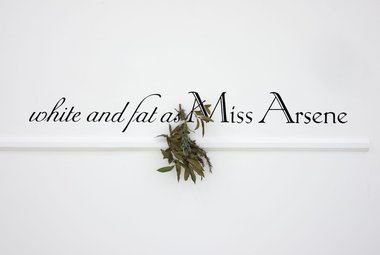
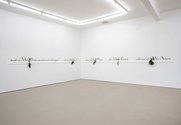
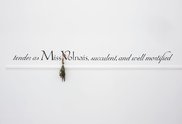







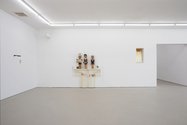

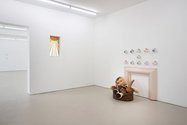

 Two Rooms presents a program of residencies and projects
Two Rooms presents a program of residencies and projects Advertising in this column
Advertising in this column



This Discussion has 0 comments.
Comment
Participate
Register to Participate.
Sign in
Sign in to an existing account.